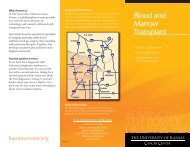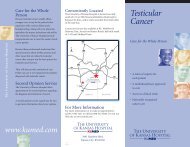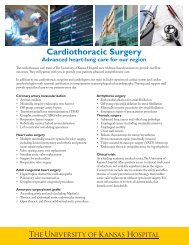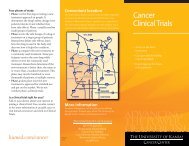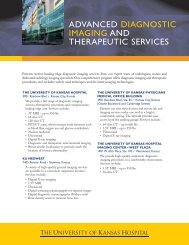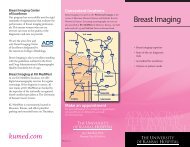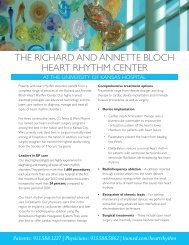The Changing Face of Interventional Medicine - The University Of ...
The Changing Face of Interventional Medicine - The University Of ...
The Changing Face of Interventional Medicine - The University Of ...
Create successful ePaper yourself
Turn your PDF publications into a flip-book with our unique Google optimized e-Paper software.
Medical Advancements at<strong>The</strong> <strong>University</strong> <strong>of</strong> Kansas Hospital<strong>Interventional</strong> Rehabilitation <strong>Medicine</strong>:<strong>The</strong> New <strong>Face</strong> <strong>of</strong> Pain ManagementRaj Mitra, MD, Chair, Rehabilitation <strong>Medicine</strong>9An accurate diagnosis, efficiencyand continuity <strong>of</strong> care – that’s whatinterventional pain managementbrings to the field <strong>of</strong> physicalmedicine and rehabilitation.Traditionally, physical medicineand rehabilitation enter into patientcare following a surgical procedure.<strong>Interventional</strong> rehabilitation medicinespecialists at <strong>The</strong> <strong>University</strong> <strong>of</strong> KansasHospital are evolving our approachto rehabilitation to benefit patientsacross the spectrum <strong>of</strong> disease. Indoing so, we have developed the largestinterventional rehabilitation programin the region. As we continue to growthis subspecialty, we are positionedto serve as a resource for the medicalcommunity and patients throughout theregion, especially those with complexhealth issues.Across the spectrum <strong>of</strong> disease<strong>Interventional</strong> rehabilitation medicineis helping a diverse patient population,from recreational athletes with sportsinjuries to cancer patients sufferingwith swallowing and chewing difficulty.Regardless <strong>of</strong> the health concern, theapproach is the same. By focusing oncollaboration, accurate diagnosis andreasonable, conservative care, we <strong>of</strong>fertreatment that helps patients findrelief or improved function throughminimally invasive options. It is anin-depth approach taking into accountphysical exams, imaging and labstudies. and multiple viewpoints fromspecialists to determine treatment.We use this approach not merely forthe sake <strong>of</strong> using an intervention, butalways to serve the patient and, whereappropriate, to break the cycle <strong>of</strong>recurring pain and future treatments.Interventions may include:• Medication management• Customized physical therapy fromtherapists specializing in spine care• Pain management injections• Interventions using fluoroscopy• Alternative medicines andtherapies, such as acupuncture,aquatic therapy, alternative painmanagement and transcutaneouselectrical nerve stimulation, orTENS.For example, adhesive capsulitis maybe treated surgically which includesrecuperation and rehabilitation.Alternatively, an interventional shoulderprotocol provides an effective option.A suprascapular nerve block is followedby an injection <strong>of</strong> an intra-articularsteroid and an injection <strong>of</strong> an anestheticagent with brisement normal salinevolume dilation. <strong>The</strong> shoulder is thenmanipulated to break adhesions.Patients quickly experience improvedshoulder abduction and flexion and asignificant improvement <strong>of</strong> motion.Comprehensive care<strong>The</strong> Marc A. Asher, MD,Comprehensive Spine Center providesa range <strong>of</strong> patient care and facilitiesunequaled in the region and rarely seenacross the nation. Here, specialists fromorthopedics, neurosurgery, physicalmedicine and rehabilitation, speech andphysical therapy and anesthesia worktogether under one ro<strong>of</strong> providing acomprehensive perspective on spinalcare. <strong>The</strong> <strong>University</strong> <strong>of</strong> Kansas Hospitalhas the only fellowship for spine andpain interventions in the region.From joint injections to cyst aspirationsto epidural injections to radi<strong>of</strong>requencyneurotomy, interventional rehabilitationspecialists rely upon a range <strong>of</strong> toolsto disrupt pain signals, improvemovement, and help patients avoid therisks <strong>of</strong> both surgery and medications.In our women’s health program,interventionalists from rehabilitation,radiology, neurology, orthopedics andanesthesia work together to restore<strong>Interventional</strong> case studyA female patient presented at<strong>The</strong> <strong>University</strong> <strong>of</strong> Kansas Hospitalsuffering chronic pelvic pain. Afteran MRI, the interventional teamdiscovered the veins in the pelviswere dilated and diagnosed pelviccongestive syndrome. Working withradiology, the team embolized theseveins and, for the first time in 12years, the patient is pain free, can sitand participate in physical therapythat was previously too painful.KUMedInnovationsSummer2013_X.indd 96/13/13 10:09 AM



